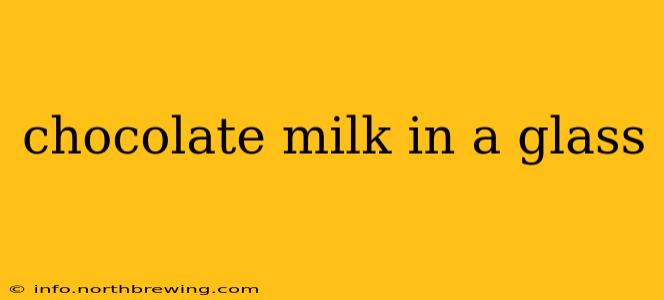Chocolate milk. The very phrase conjures up images of childhood, comfort, and a deliciously creamy indulgence. But beyond the nostalgic appeal, there's a surprising depth to this seemingly simple beverage. This post will delve into everything from the perfect chocolate milk recipe to its nutritional value and even its cultural significance. Let's pour ourselves a glass and explore!
What are the benefits of drinking chocolate milk?
Chocolate milk offers a unique blend of benefits, particularly for those involved in physical activity. It provides a readily available source of carbohydrates for energy replenishment, along with protein to aid muscle recovery. The carbohydrates in the milk sugar (lactose) and the added chocolate provide quick energy, while the protein in the milk helps repair and rebuild muscle tissue after exercise. It's not just for kids – many athletes appreciate chocolate milk's post-workout advantages. However, it's crucial to remember that moderation is key, as it's also relatively high in sugar and calories.
Is chocolate milk good for you?
The "good for you" question is complex. It depends entirely on the type of chocolate milk and how much you consume. Homemade versions, using low-fat milk and unsweetened cocoa powder, are generally healthier than commercially produced varieties often loaded with added sugars. These added sugars can contribute to weight gain, dental problems, and other health issues. So, while the natural nutrients in milk offer several benefits, the added sugar content in many chocolate milks significantly impacts its overall health profile. Look for brands with lower sugar content or consider making your own to control the ingredients.
How many calories are in a glass of chocolate milk?
The calorie count varies dramatically depending on the brand, the type of milk used (skim, 2%, whole), and the amount of chocolate added. A typical 8-ounce serving of commercially produced chocolate milk can range from 100 to 200 calories or more. Homemade versions, using low-fat milk and a moderate amount of cocoa powder, will generally have fewer calories. Always check the nutrition label to get an accurate calorie count for your specific chocolate milk.
What is the best way to make chocolate milk?
The best way to make chocolate milk is to prioritize quality ingredients and control the sweetness. Start with cold, low-fat milk (skim or 1%) for a healthier option. Use unsweetened cocoa powder – this allows you to control the sweetness level. Mix the cocoa powder with a small amount of the milk to create a smooth paste, preventing clumps. Then add the remaining milk and stir well. Add a touch of sweetener like honey or maple syrup to taste, if desired. Experiment with different levels of cocoa powder to reach your preferred chocolate intensity. You can also add a pinch of cinnamon or vanilla extract for an extra flavor boost.
What's the difference between chocolate milk and cocoa?
While both chocolate milk and cocoa beverages offer chocolatey goodness, there's a crucial distinction: chocolate milk is made with milk, while cocoa is typically made by mixing cocoa powder with water or milk. This fundamental difference leads to variations in texture, nutritional profile, and overall taste. Cocoa tends to be richer and more intense in flavor, while chocolate milk offers a smoother, creamier experience due to the milk’s fat content.
Why is chocolate milk so popular?
The popularity of chocolate milk stems from a blend of factors. It's a delicious and convenient beverage that satisfies both sweet and creamy cravings. It's associated with happy childhood memories for many, creating a powerful emotional connection. Its nutritional benefits, particularly its combination of carbohydrates and protein, contribute to its appeal among athletes and active individuals. Finally, the readily available and diverse range of commercially produced chocolate milk ensures its widespread accessibility.
This exploration highlights the multifaceted world of chocolate milk, moving beyond the simple pleasure to uncover its nutritional aspects, preparation methods, and cultural significance. So, the next time you pour yourself a glass, remember there's more to this beloved beverage than meets the eye!
